Dutch Ambitions - the Netherlands going Axis
- Thread starter Gormytorysh
- Start date
-
We have updated our Community Code of Conduct. Please read through the new rules for the forum that are an integral part of Paradox Interactive’s User Agreement.
You are using an out of date browser. It may not display this or other websites correctly.
You should upgrade or use an alternative browser.
You should upgrade or use an alternative browser.
Well, that was unexpected. Guess that's what happens when a nation gets too comfy and have the belief that they were safe with the Atlantic between them and Europe. No one is safe from the Dutch! 
Where is the American navy? Are they too busy partying in Pearl Harbor waiting for that surprise military strike that would never take place?
I can't wait for the surprises you mentioned. Let's hope the Americans put up more resistance or the AAR is definitely coming to a close quickly.
Where is the American navy? Are they too busy partying in Pearl Harbor waiting for that surprise military strike that would never take place?
I can't wait for the surprises you mentioned. Let's hope the Americans put up more resistance or the AAR is definitely coming to a close quickly.
Link is in my sig
Oops, didn't notice that :blink:. I'll check it out, I might pick up some things for future AAR's.
Well, that was unexpected. Guess that's what happens when a nation gets too comfy and have the belief that they were safe with the Atlantic between them and Europe. No one is safe from the Dutch!
Two things are for sure, 1) I expected a lot more resistance. But let's see what is to come. 2) Never underestimate the Dutch
Where is the American navy? Are they too busy partying in Pearl Harbor waiting for that surprise military strike that would never take place?
I can't wait for the surprises you mentioned. Let's hope the Americans put up more resistance or the AAR is definitely coming to a close quickly.
Their navy is pretty much occupied by the Japanese who are doing their part in the Pacific. But even if their navy would have patrolled the northern Atlantic after a first (attempt of) landing, my southern army would probably have surprised them, but that's speculation.
Are you sure you want to know?
There will be a lot of resistance, believe me! Disappointing eh?
So. Germans are waiting for you for the great party?
Well.... I was throwing the party and they missed it, so they create their own party. But if they make the mess, they can clean it themselves!
Chapter 8: Operation: Hunting for Eagles – part 2
January 1943 – December 1943
The advance was going much faster than as planned and the Dutch hard difficulties getting reinforcements and supplies to the front. Factories on the European mainland were producing 24/7 and convoys sailed between Europe and North America on a ongoing basis. In addition, finding suitable men to fill the divisions was getting a bigger problem. From the newly acquired territories men did enlist, but not as much as was needed to keep a strong army.
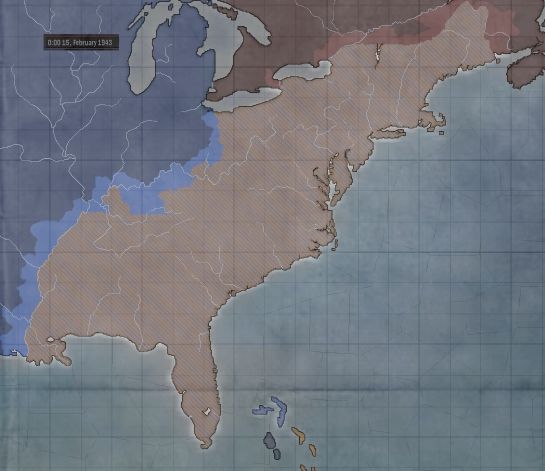
Expansions up to February 15th 1943
In Europe declaring war on Poland and Czechoslovakia proved to be a wise decision. Both countries were defeated quite fast and the Soviets had been concentrating their army mostly on the southern front. Romania was overrun by the Russian Bear and they were fighting Hungarian, Bulgarian and Italian troops mostly and only a few German troops. With the fall of Poland and Czechoslovakia, Germany was able to thrust into the center of the Soviet Army.
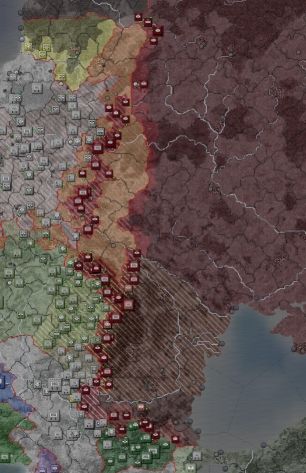
In May the Dutch advance was halted by the US army. Roughly a line from Chicago to New Orleans became the fighting front where heavy battles were fought. Especially in the middle of the front the Dutch army struggled and lost quite a few battles, however, the US army was not decisive enough to punch a hole in the Dutch defenses. Having enough manpower to fill up the army became an alarming problem now and was the main reason why battles were lost, but more importantly, why the Dutch army could not get any further. Dramatic measures had to be taken and Prince Bernhard made his choice by disbanding some home defenses, taking men off 3rd fleet and to disband the small airforce and use these men for battle, which where they were needed most. These inexperienced soldiers would not solve the problem entirely, but did make sure that the US army would not break through the lines. This frontline would stay there for at least 6 months and sometimes the US army got a minor victory and another time the Dutch would. US WWI veterans had flashbacks while they were stationed in France almost 20 years ago.
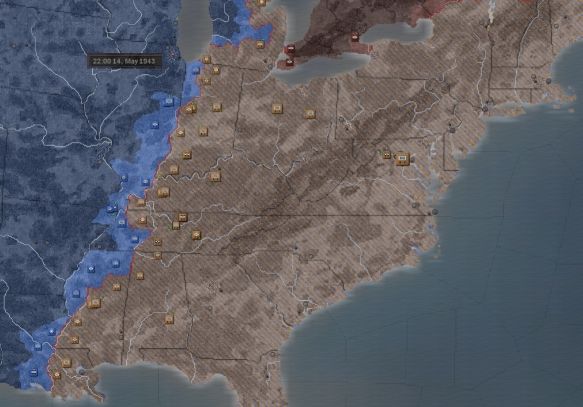
The 6 month frontline
In October 1943 the Dutch forces finally managed to book some successes in the middle of the frontline and break through. When the US tried to stop the Netherlands there, the northern front started to show weaknesses. Eventually the Dutch steamroller began to work again, though not as fast is it was previously. 7th Corps was completely exhausted and 8th corps had only half the amount of manpower left compared to the landing. A fresh corps arrived in New Orleans but lacked the combat experience to be of any use and was not able to anything but to hold the line there in the hopes the men up north could make a diference. A complete success was still not assured and the biggest problem, having enough men to fill the armies, could still be a reason for loosing the battle in the US.
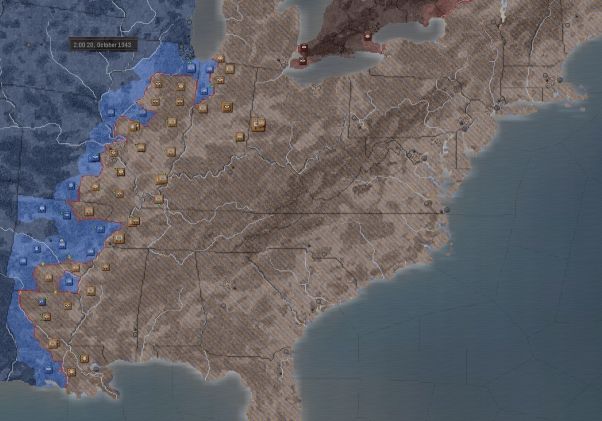
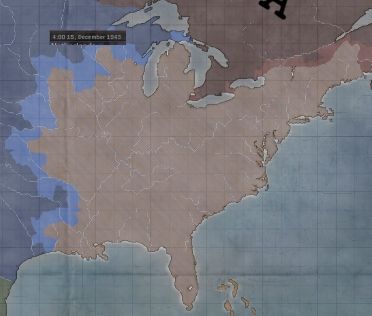
Dutch progress in December, 1943
In this 6 month period the Germans however were making great progress in the Soviet Union. Especially due to a major part of the Soviet army was kept busy in the Balkans, who could not provide any help in stopping the German army. For the first time this war Germany showed it’s potential. On November 3rd, 1943 Stalingrad fell into the hands of Germany and Moscow was about to be surrounded by the Germans.
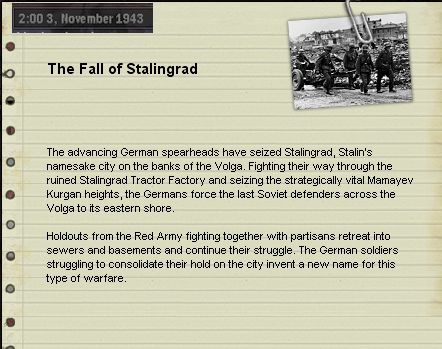
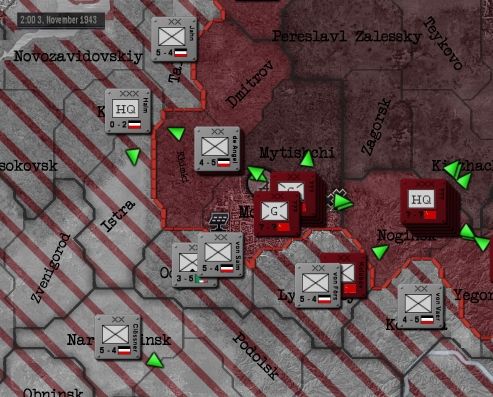
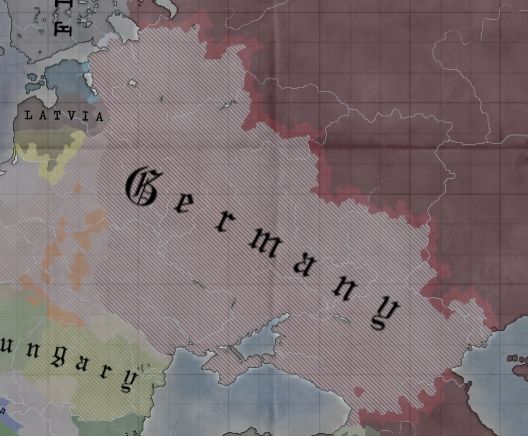
Next chapter: Operation: Hunting for Eagles - Part 3
January 1943 – December 1943
The advance was going much faster than as planned and the Dutch hard difficulties getting reinforcements and supplies to the front. Factories on the European mainland were producing 24/7 and convoys sailed between Europe and North America on a ongoing basis. In addition, finding suitable men to fill the divisions was getting a bigger problem. From the newly acquired territories men did enlist, but not as much as was needed to keep a strong army.

Expansions up to February 15th 1943
In Europe declaring war on Poland and Czechoslovakia proved to be a wise decision. Both countries were defeated quite fast and the Soviets had been concentrating their army mostly on the southern front. Romania was overrun by the Russian Bear and they were fighting Hungarian, Bulgarian and Italian troops mostly and only a few German troops. With the fall of Poland and Czechoslovakia, Germany was able to thrust into the center of the Soviet Army.

In May the Dutch advance was halted by the US army. Roughly a line from Chicago to New Orleans became the fighting front where heavy battles were fought. Especially in the middle of the front the Dutch army struggled and lost quite a few battles, however, the US army was not decisive enough to punch a hole in the Dutch defenses. Having enough manpower to fill up the army became an alarming problem now and was the main reason why battles were lost, but more importantly, why the Dutch army could not get any further. Dramatic measures had to be taken and Prince Bernhard made his choice by disbanding some home defenses, taking men off 3rd fleet and to disband the small airforce and use these men for battle, which where they were needed most. These inexperienced soldiers would not solve the problem entirely, but did make sure that the US army would not break through the lines. This frontline would stay there for at least 6 months and sometimes the US army got a minor victory and another time the Dutch would. US WWI veterans had flashbacks while they were stationed in France almost 20 years ago.

The 6 month frontline
In October 1943 the Dutch forces finally managed to book some successes in the middle of the frontline and break through. When the US tried to stop the Netherlands there, the northern front started to show weaknesses. Eventually the Dutch steamroller began to work again, though not as fast is it was previously. 7th Corps was completely exhausted and 8th corps had only half the amount of manpower left compared to the landing. A fresh corps arrived in New Orleans but lacked the combat experience to be of any use and was not able to anything but to hold the line there in the hopes the men up north could make a diference. A complete success was still not assured and the biggest problem, having enough men to fill the armies, could still be a reason for loosing the battle in the US.


Dutch progress in December, 1943
In this 6 month period the Germans however were making great progress in the Soviet Union. Especially due to a major part of the Soviet army was kept busy in the Balkans, who could not provide any help in stopping the German army. For the first time this war Germany showed it’s potential. On November 3rd, 1943 Stalingrad fell into the hands of Germany and Moscow was about to be surrounded by the Germans.



Next chapter: Operation: Hunting for Eagles - Part 3
Chapter 9: Operation: Hunting for Eagles – part 3
1944 – 1945
In December 1943 the Australians managed to attack the Dutch East Indies. The Netherlands always thought it was safe with the Japanese forces in the area who kept an eye. However, they seemed to be busy with the US navy and capturing small islands, hence the vulnerability of the East Indies.
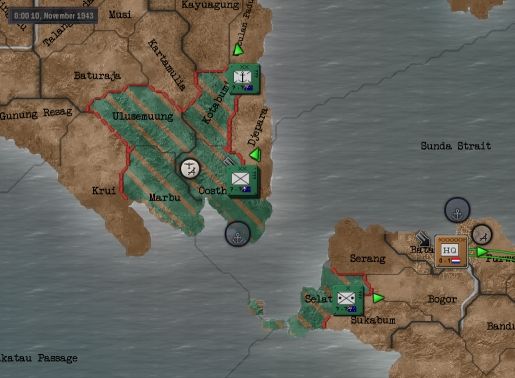
While Australia was trying to force something for the Comintern, the head of the faction was in big trouble. Germany surrounded Moscow in Februari 1944 and it was only a matter of time for the Soviets to surrender.
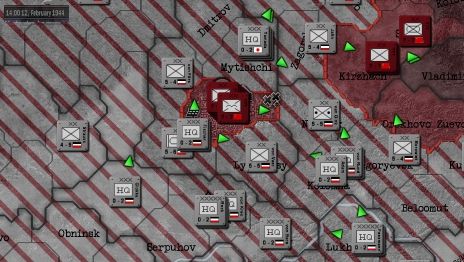
Germany met little resistance in Europe and the German Diesel Engine could not be stopped. Instead of taking Moscow, the Germans besieged the city making sure no one could go in or get out and the rest of the army would move further into Soviet territory. In the summer of 1943, the Red Army was devastated and surrendered to the Axis. As (considered to be) the strongest within the faction, the Soviets made a peace treaty with the Dutch, also due to the more liberal politics compared to the fascist Germans.

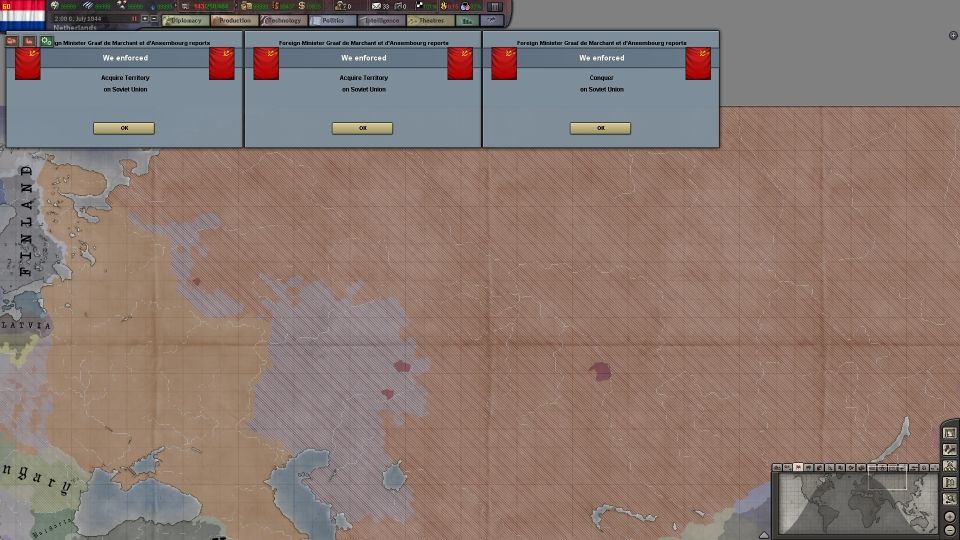
Meanwhile in the west, the Netherlands could not spare any division to defend a landing on the US east coast, they decided to capture the Panama Canal. This way if the US had any ambition in launching an assault, they at least have to make their way around South America which would not be desirable to them. In February the 1e Marine Korps launched an attack on Panama Canal and without any troops to defend it, it was easily taken.
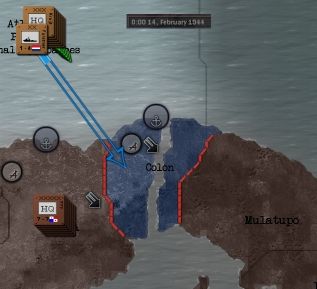
On US soil the southern front was making its first progress and moved to the Mexican border. Once fresh recruits, now men with combat experience showed signs of potential. The US government moved further west for the 4th time. After leaving Washington, they were seated in Chicago, Minnesota and now San Fransisco. Prince Bernhard came up with another daring plan; the southern divisions were to move along the Mexican border towards San Diego and capture the port there. This would open up a harbour on the west coast for new supply lines and more importantly, reinforcements. The plan was to be executed after the Soviets surrendered.
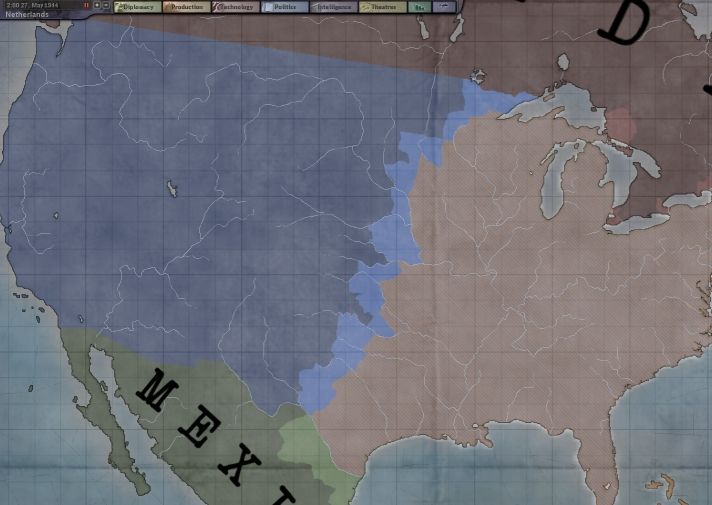
Progress up to May 1944
After the Soviets surrendered, Dutch propoganda was initiated. The Dutch army needed more men, a lot more even and who best to address than defeated anti communist Russians? They were offered a decent pay, no one shooting them in the back if refusing unrealistic orders and a winning ‘team’. A lot of young men could not resist this offer and with most having combat experience, training was hardly needed. They were given a uniform, new weapons with instructions in Russian and shipped to the west. In the months that followed, the Dutch army filled the ranks and began a great offensive. South corps executed the plan and in October 1944 San Diego was captured. Little resistance was offered and the Russians in Dutch service showed the world the greatness of the Dutch Army.
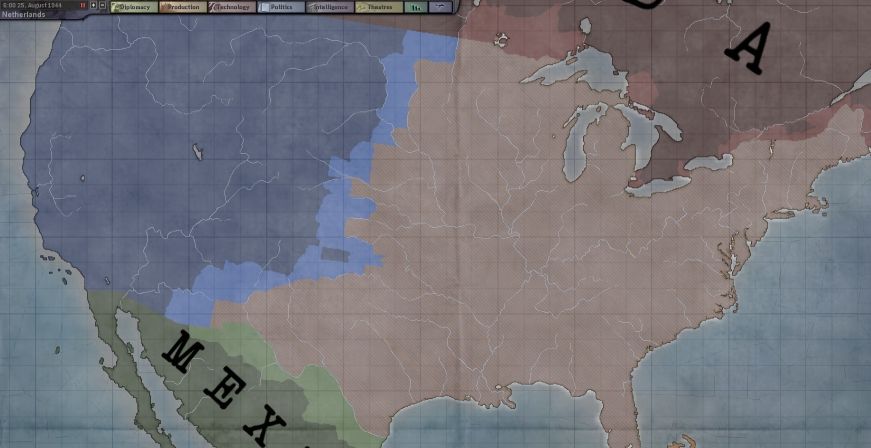
South Corps on the move along the Mexican border
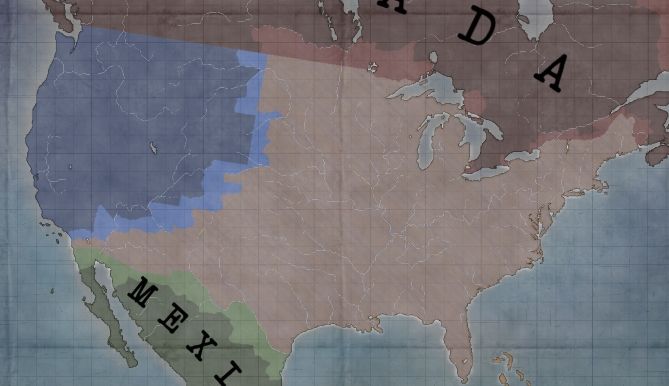
San Diego taken
After capturing San Diego it was an easy move to Los Angeles and when still no resistance was offered, San Fransisco was attacked. While the Americans won the battle, just being attacked again where the president is residing was enough to surrender to the Dutch. After 33 months of fighting on US soil, the Netherlands could call it’s self a grand victor.
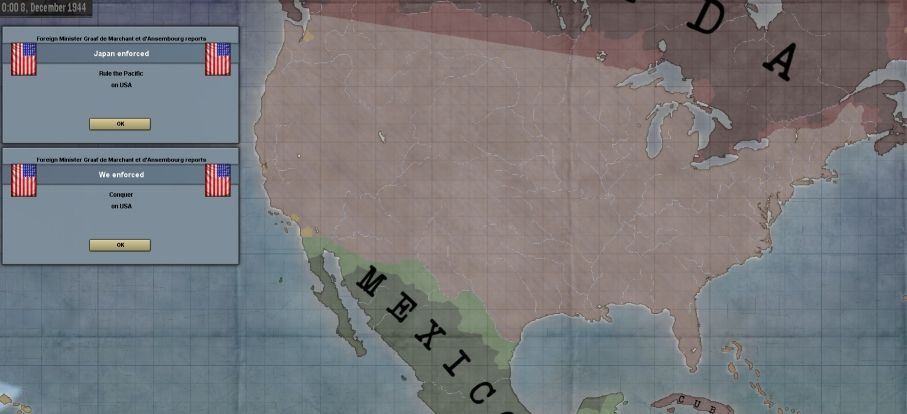
1944 – 1945
In December 1943 the Australians managed to attack the Dutch East Indies. The Netherlands always thought it was safe with the Japanese forces in the area who kept an eye. However, they seemed to be busy with the US navy and capturing small islands, hence the vulnerability of the East Indies.

While Australia was trying to force something for the Comintern, the head of the faction was in big trouble. Germany surrounded Moscow in Februari 1944 and it was only a matter of time for the Soviets to surrender.

Germany met little resistance in Europe and the German Diesel Engine could not be stopped. Instead of taking Moscow, the Germans besieged the city making sure no one could go in or get out and the rest of the army would move further into Soviet territory. In the summer of 1943, the Red Army was devastated and surrendered to the Axis. As (considered to be) the strongest within the faction, the Soviets made a peace treaty with the Dutch, also due to the more liberal politics compared to the fascist Germans.


Meanwhile in the west, the Netherlands could not spare any division to defend a landing on the US east coast, they decided to capture the Panama Canal. This way if the US had any ambition in launching an assault, they at least have to make their way around South America which would not be desirable to them. In February the 1e Marine Korps launched an attack on Panama Canal and without any troops to defend it, it was easily taken.

On US soil the southern front was making its first progress and moved to the Mexican border. Once fresh recruits, now men with combat experience showed signs of potential. The US government moved further west for the 4th time. After leaving Washington, they were seated in Chicago, Minnesota and now San Fransisco. Prince Bernhard came up with another daring plan; the southern divisions were to move along the Mexican border towards San Diego and capture the port there. This would open up a harbour on the west coast for new supply lines and more importantly, reinforcements. The plan was to be executed after the Soviets surrendered.

Progress up to May 1944
After the Soviets surrendered, Dutch propoganda was initiated. The Dutch army needed more men, a lot more even and who best to address than defeated anti communist Russians? They were offered a decent pay, no one shooting them in the back if refusing unrealistic orders and a winning ‘team’. A lot of young men could not resist this offer and with most having combat experience, training was hardly needed. They were given a uniform, new weapons with instructions in Russian and shipped to the west. In the months that followed, the Dutch army filled the ranks and began a great offensive. South corps executed the plan and in October 1944 San Diego was captured. Little resistance was offered and the Russians in Dutch service showed the world the greatness of the Dutch Army.

South Corps on the move along the Mexican border

San Diego taken
After capturing San Diego it was an easy move to Los Angeles and when still no resistance was offered, San Fransisco was attacked. While the Americans won the battle, just being attacked again where the president is residing was enough to surrender to the Dutch. After 33 months of fighting on US soil, the Netherlands could call it’s self a grand victor.

Wonder what happened to the Aussie’s in the East Indies? They came, they saw, they conquered and they lost……

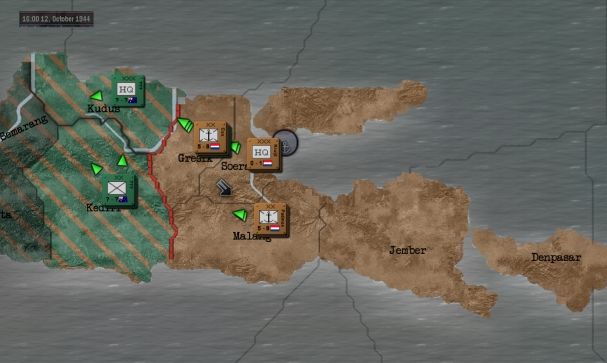
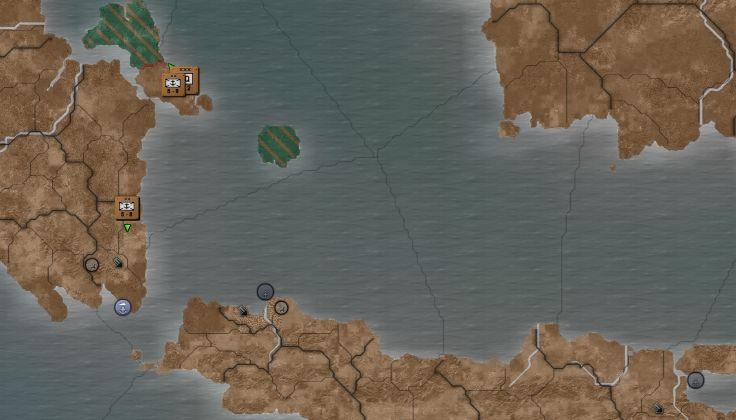



THE END OF THIS AAR
Ironically, the Soviets contributed to the fall of USA. The Dutch are victorious, as expected. One can only imagine the problems that would arise from all the newly conquered territories. The people won't submit to a foreign power just overnight. Good job and I look forward to your next AAR.
Ironically, the Soviets contributed to the fall of USA. The Dutch are victorious, as expected. One can only imagine the problems that would arise from all the newly conquered territories. The people won't submit to a foreign power just overnight. Good job and I look forward to your next AAR.
The irony is the fun part of it all
What a mess the East is now
I know, and wasn't fully planned. I wanted the western part of the USSR, but I got almost all haha.

